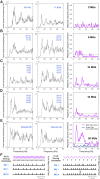Beta-band motor unit coherence and nonlinear surface EMG features of the first dorsal interosseous muscle vary with force
- PMID: 31365308
- PMCID: PMC6766730
- DOI: 10.1152/jn.00228.2019
Beta-band motor unit coherence and nonlinear surface EMG features of the first dorsal interosseous muscle vary with force
Abstract
Motor unit firing times are weakly coupled across a range of frequencies during voluntary contractions. Coherent activity within the beta-band (15-35 Hz) has been linked to oscillatory cortical processes, providing evidence of functional connectivity between the motoneuron pool and motor cortex. The aim of this study was to investigate whether beta-band motor unit coherence is altered with increasing abduction force in the first dorsal interosseous muscle. Coherence between motor unit firing times, extracted from decomposed surface electromyography (EMG) signals, was investigated in 17 subjects at 10, 20, 30, and 40% of maximum voluntary contraction. Corresponding changes in nonlinear surface EMG features (specifically sample entropy and determinism, which are sensitive to motor unit synchronization) were also examined. A reduction in beta-band and alpha-band coherence was observed as force increased [F(3, 151) = 32, P < 0.001 and F(3, 151) = 27, P < 0.001, respectively], accompanied by corresponding changes in nonlinear surface EMG features. A significant relationship between the nonlinear features and motor unit coherence was also detected (r = -0.43 ± 0.1 and r = 0.45 ± 0.1 for sample entropy and determinism, respectively; both P < 0.001). The reduction in beta-band coherence suggests a change in the relative contribution of correlated and uncorrelated presynaptic inputs to the motoneuron pool, and/or a decrease in the responsiveness of the motoneuron pool to synchronous inputs at higher forces. The study highlights the importance of considering muscle activation when investigating changes in motor unit coherence or nonlinear EMG features and examines other factors that can influence coherence estimation.NEW & NOTEWORTHY Intramuscular alpha- and beta-band coherence decreased as muscle contraction force increased. Beta-band coherence was higher in groups of high-threshold motor units than in simultaneously active lower threshold units. Alterations in motor unit coherence with increases or decreases in force and with the onset of fatigue were accompanied by corresponding changes in surface electromyography sample entropy and determinism. Mixed-model analysis indicated mean firing rate and number of motor units also influenced the coherence estimate.
Keywords: EMG; coherence; determinism; motor unit; sample entropy.
Conflict of interest statement
No conflicts of interest, financial or otherwise, are declared by the authors.
Figures








Similar articles
-
Muscle fatigue increases beta-band coherence between the firing times of simultaneously active motor units in the first dorsal interosseous muscle.J Neurophysiol. 2016 Jun 1;115(6):2830-9. doi: 10.1152/jn.00097.2016. Epub 2016 Mar 16. J Neurophysiol. 2016. PMID: 26984420 Free PMC article.
-
The Influence of Force Level and Motor Unit Coherence on Nonlinear Surface EMG Features Examined Using Model Simulation.Annu Int Conf IEEE Eng Med Biol Soc. 2019 Jul;2019:6616-6619. doi: 10.1109/EMBC.2019.8857299. Annu Int Conf IEEE Eng Med Biol Soc. 2019. PMID: 31947358
-
Beta-range EEG-EMG coherence with isometric compensation for increasing modulated low-level forces.J Neurophysiol. 2009 Aug;102(2):1115-20. doi: 10.1152/jn.91095.2008. Epub 2009 May 20. J Neurophysiol. 2009. PMID: 19458142
-
Rhythmical corticomotor communication.Neuroreport. 1999 Feb 5;10(2):R1-10. Neuroreport. 1999. PMID: 10203308 Review.
-
[Research progress on analysis methods in electroencephalography-electromyography synchronous coupling].Sheng Wu Yi Xue Gong Cheng Xue Za Zhi. 2019 Apr 25;36(2):334-337. doi: 10.7507/1001-5515.201804005. Sheng Wu Yi Xue Gong Cheng Xue Za Zhi. 2019. PMID: 31016953 Free PMC article. Review. Chinese.
Cited by
-
Biomechanical modeling for the estimation of muscle forces: toward a common language in biomechanics, medical engineering, and neurosciences.J Neuroeng Rehabil. 2023 Sep 26;20(1):130. doi: 10.1186/s12984-023-01253-1. J Neuroeng Rehabil. 2023. PMID: 37752507 Free PMC article. Review.
-
Analysis and Biophysics of Surface EMG for Physiotherapists and Kinesiologists: Toward a Common Language With Rehabilitation Engineers.Front Neurol. 2020 Oct 15;11:576729. doi: 10.3389/fneur.2020.576729. eCollection 2020. Front Neurol. 2020. PMID: 33178118 Free PMC article.
-
Neural Filtering of Physiological Tremor Oscillations to Spinal Motor Neurons Mediates Short-Term Acquisition of a Skill Learning Task.eNeuro. 2024 Jul 17;11(7):ENEURO.0043-24.2024. doi: 10.1523/ENEURO.0043-24.2024. Print 2024 Jul. eNeuro. 2024. PMID: 38866498 Free PMC article.
-
Beta-band power classification of go/no-go arm-reaching responses in the human hippocampus.J Neural Eng. 2024 Jul 15;21(4):046017. doi: 10.1088/1741-2552/ad5b19. J Neural Eng. 2024. PMID: 38914073 Free PMC article.
-
Effects of Future Information and Trajectory Complexity on Kinematic Signal and Muscle Activation during Visual-Motor Tracking.Entropy (Basel). 2021 Jan 15;23(1):111. doi: 10.3390/e23010111. Entropy (Basel). 2021. PMID: 33467619 Free PMC article.
References
Publication types
MeSH terms
LinkOut - more resources
Full Text Sources
Miscellaneous

